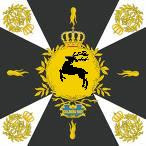
General von Kress with his detatchment
In response to this, the Elector Ulrich von Luftberg observed the approaching mass of bluecoats and deployed his own force as per his prepared scheme. His flanks were anchored on his right by the stream, while the left rested on the village of Vogelhof itself. These houses were occupied by the fearsome Pilsen Grenadiers, under the direct command of Conrad von Hentsch himself with orders to hold out to the death.
Vogelhof, with von Hentsch and the grenadiers (yes, I know I need to make some model houses...)
The army’s main line was drawn up in a double-line of infantry, interspersed with artillery batteries and backed by the army’s cavalry in reserve. It was a daunting defence, but as predicted the smaller side of the field over the stream was all but abandoned, save for General Figling’s Croats stationed in a wood to cover the bridge in the army’s right-rear.
The main Luftberg battle line

Map of the battle: Initial moves
As dawn light gathered the Aschenbach army approached the enemy on both sides of the river, the isolated detachment under von Kress functioning perfectly well in isolation. Sweeping on, the Aschenbach infantry on the right of their line under General Grenwitz forged ahead to attack the village of Vogelhof. IR7 von Dunkel’s men rapidly learned that grenadiers might be a tough prospect in the open, but behind stone and timber they were even more dangerous. Even forced by this to refuse a flank, the Aschenbach line swept on, folding smoothly out into line and perfectly timing it’s attack to take the initiative in the ensuing firefight. The Luftberg infantry were outclassed man for man, but with batteries of guns hidden all along their line they managed to hold their own. Everywhere, batteries of guns fired into the oncoming enemy, especially from the small wood bristling with cannon in the centre of the Luftberg line.
The infantry lines clash, as viewed from Vogelhof
General von Kleintrink had moved his cavalry forward, only to realise that with Vogelhof in hostile hands he couldn’t move ahead to turn the enemy flank. To sit tight was possibly the best course, but for Graf Erich von Kleintrink, the man who had demolished the enemy flank at Neukatzberg, such a thing was unthinkable. The only option to get at the enemy was a risky change into column, in order to slip through a narrow passage through the rocky ground east of the village. If he moved fast enough, outpacing the more sluggish enemy commanders, he could fall on the enemy’s flank and rear before they responded and win yet another battle…
von Kleintrink flanks the rocky ground

Initial combat and outflanking moves







2 comments:
Wow,great report and photos!I really enjoy your site, it's one of the best. Keep up the good work and thanks for the inspiration.
Best regards...Bill
I agree. You're doing a great job. Now to skip ahead and read "Part Two".
-- Jeff
Post a Comment